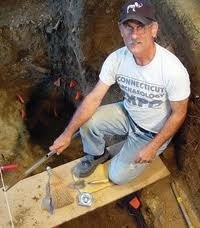Selected Reprints
News from the Office of State Archaeology
by Nick Bellantoni ... his last article as CT State Archaeologist As I begin to write this news report, it impresses me that this will be the last issue of the FOSA Newsletter that I will
participate in as the Connecticut State Archaeologist. As most of you are aware, I will be retiring this year in September,
after almost three decades serving in my official capacity. So, writing this last article brings back a flood of memories.
As I begin to write this news report, it impresses me that this will be the last issue of the FOSA Newsletter that I will
participate in as the Connecticut State Archaeologist. As most of you are aware, I will be retiring this year in September,
after almost three decades serving in my official capacity. So, writing this last article brings back a flood of memories.
Like my first day as state archaeologist in 1987 when I was given a small (and I mean, small) office in Beach Hall. The
room was so small that a meeting with two people looked like the stateroom scene in a Marx Brother's movie! A far cry from
my current, spacious corner "suite" at the Museum of Natural History and Archaeology Center building.
We started our earliest projects conducting rescue excavations with no field staff, but we did have a reliable and
expert amateur archaeology community, led by Dave Cooke, ready to assist: These included the Walton Cemetery site with our
own "vampire"; the exhumation and repatriation of Henry Opukaha'ia, historically referred to as the first Christianized
Native Hawaiian; and the Chauncey Tomb vandalism at Indian Hill Cemetery, Middletown, to mention a few.
As the projects piled up and the demands of our office became greater, June Cooke came to me in 1997 with an idea of
forming a "Friends" group to assist in volunteer efforts. I don't want to say I was skeptical, but I thanked her and told
her to "go for it," not really expecting much to develop from the concept.
Boy, was I in for a shocker!
Armed with an ever growing "army" of FOSA volunteers, we were able to assist on the Broteer Venture Smith burial
excavations; the Bulkeley Tomb restoration in Colchester; the Samuel Huntington Tomb in Norwichtown; the Rogers Site in
Lisbon; the Bradley (1941) airplane crash site in Windsor Locks; and, the exhumation and repatriation of Albert Afraid of
Hawk to, again, mention a few.
One thing remains clear to me, and that is we could never have conducted any of these research and preservation
investigations without FOSA volunteers throughout the years. You have given me an extraordinary "workforce" that could
never have been paid for from any state coffers. I truly understand the importance of what you have given to me; however,
we are sometimes at a loss in terms of what we have given back to you for your service. Hopefully, we have involved you in
some interesting projects and meaningful volunteer work. Other than that, you all have given to me far more than I could
ever give back.
To all that have sat on the FOSA Board of Directors, thank you for all your hard work and long hours dedicated to the
success of this organization. To all of you that have volunteered your time and expertise in the field, laboratory, library,
and on public outreach programs, thank you for all you have done, you are the backbone of FOSA. And, to all of you
that simply pay your membership dues to support FOSA, thank you because you are the basic support of the organization.
I leave knowing that FOSA is in great hands. I am especially gratified to see so many young people like our new
president, Mandy Ranslow, take on such an active role in directing FOSA into the future. My hope is that you will provide
the next state archaeologist with the same support and dedication you have given me. I can't tell you how indebted I am to
you, other than to say that I will cherish your friendships for as long as I can sing the Sinatra song: "The Best Is Yet
To Come."
Nicholas Bellantoni, PhD, State Archaeologist